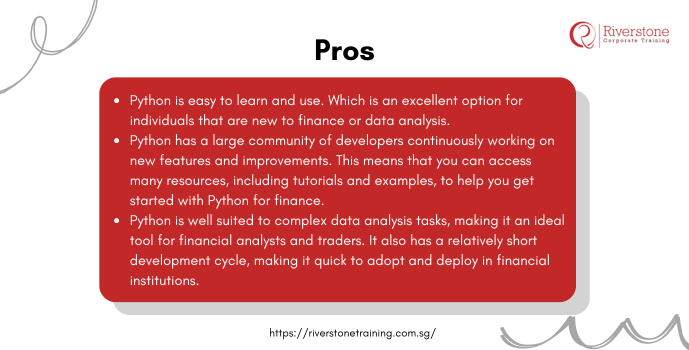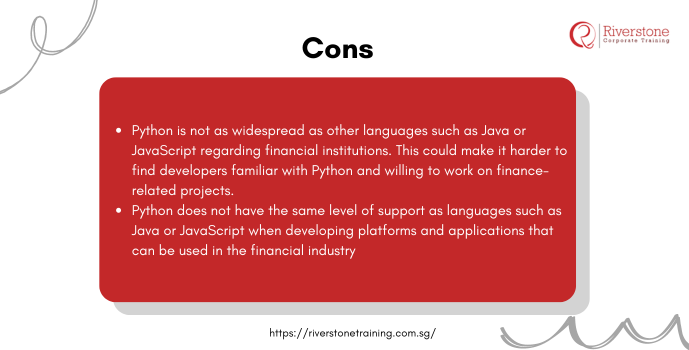
Best Python for Finance Course
Python is an advanced programming language that can be used for a variety of various purposes, such as developing web applications, creating scientific simulations, or crunching numbers in finance. This course will teaches you the fundamentals of Python and how to use it to tackle everyday finance tasks.
If you’re interested in learning Python for finance, this course is a great place to start. Our tutors will show you the fundamentals of Python programming, including how to create basic programs, work with data files, and manipulate text strings. It will also be taught to you how to use Python for finance tasks, such as financial modeling and analysis, stock analysis, and financial forecasting. This python finance training with certification also includes a hands-on financial modeling class to help reinforce practical applications.
In this course, you’ll learn:
- How to install Python on your computer
- How to use the Python interpreter
- The basic syntax of the Python language
- How to make and edit files in the Python environment
- How to work with data files in Python
- How to perform basic mathematical operations in Python
- How to use modules in the Python environment
What is Python?
Python is a high-level, interpreted, general-purpose programming language with various modules and libraries to support complex application development. It has various features that make it well suited for finance, such as its ability to handle large data sets, its standard library’s support for financial tools, and its syntax, which is familiar to most programmers.
One of the most popular Python finance libraries is pandas. It provides low-level data structures and methods for working with arrays, data frames, and data lists. Finance libraries are essential for developing Python because of their wide range of supported features.
Why use Python for Finance?
Python is a popular programming language for data-driven applications, including finance. This article will examine some pros and cons of using Python for finance purposes.
Pros:
- Python is easy to learn and use. Which is an excellent option for individuals that are new to finance or data analysis.— especially those enrolling in an advanced financial analysis course Singapore institutions offer.
- Python has a large community of developers continuously working on new features and improvements. This means that you can access many resources, including tutorials and examples, to help you get started with Python for finance.
- Python is well suited to complex data analysis tasks, making it an ideal tool for financial analysts and traders. It also has a relatively short development cycle, making it quick to adopt and deploy in financial institutions.
Cons:
- Python is not as widespread as other languages such as Java or JavaScript regarding financial institutions. This could make it harder to find developers familiar with Python and willing to work on finance-related projects.
- Python does not have the same level of support as languages such as Java or JavaScript when developing platforms and applications that can be used in the financial industry.
What are the basic concepts of Python for Finance?
Python is a type of code that can be utilized for a various of tasks, including data analysis, software development, and finance. Throughout this article, we cover the foundations of Python for finance, including its syntax and some important features that make it an effective tool for financial professionals. It is also commonly introduced in short finance certification courses in Singapore, especially those tailored for aspiring analysts or finance professionals transitioning into tech roles.
Python is a versatile programming language that can be used for various purposes. Through this article, we will focus on its use in finance. Specifically, we will discuss Python’s syntax and critical features that make it a powerful tool for financial professionals. It is widely taught in practical financial modeling courses for Singapore professionals, given its capabilities in financial data handling and automation.
Python is popular among software development communities because it has an easy-to-read syntax and can handle large data sets. Its popularity in finance stems from its versatility and speed. Python can be utilize to make programs that perform complex financial calculations or to develop front-end applications that interact with financial databases. Additionally, Python is relatively easy to learn and incorporates concepts from other languages such as C++ and Java into its syntax.
Through this article, it will cover the following topics:
- What is Python?
- What are the basic syntaxes of Python?
- What are some key features of Python for finance?
- How do you use Python for
What is the best Python for Finance Course?
Python has become one of the most extensively used programming languages in the world. It’s easy to learn and has many applications, including finance.
Based on our research, this post contains a list of the best Python for finance courses.
- Python for Finance from Data Camp
This course from Data Camp is designed for beginners who want to learn how to use Python for data analysis and financial modeling. The course includes video lectures, code modules, and quizzes and is available in both online and offline formats. - Python for Finance Bootcamp from Udacity
Udacity’s Python for Finance Bootcamp is a comprehensive course that covers the basics of finance using Python. The course includes video lectures, exercises, and programming assignments. It’s available online and offline and is designed for experienced programmers. - Introduction to Financial Modelling with Python from Coursera
Coursera’s Introduction to Financial Modelling with Python teaches beginners how to use Python for financial modeling. The course includes video lectures, exercises, and programming assignments. It’s available online and offline and is designed for experienced programmers.
How to Install Python for Finance
Python is a widely used language for finance and accounting procedures. It can be installed on your computer in a few minutes, making it an ideal choice for in-depth financial analysis. If you’re just starting out, enrolling in a beginner accounting short course Singapore can help you understand how Python supports financial data processing and reporting. Moreover, learning why financial analysis is important for Python finance can give you the necessary insights to apply data-driven techniques for better decision-making. To install Python for finance on your computer, follow these simple steps:
- Go to the official website for Python and download the installer.
- Run the installer and follow the instructions.
- When the installation has finished, you will be able to open Python by selecting “Python 3″from the Start menu or typing “python” into the Windows search bar.
- To use Python for finance, you must first import the necessary modules. To do this, type “import” into the interpreter window and provide the module name you want to use. For example, if you’re going to use the matplotlib module, you would type “import matplotlib.”
- Next, you should create a new file called “finance.py” and enter the following code:# Finance script import pandas as PD # Dataframe for financial data df = PD. DataFrame ( [ ‘StockPrice ‘ , ‘ EPS ‘ , ‘ Dividend ‘ ] ) # Create a dataframe of financial data 1 2 3 4 5 6 7 8 9 1011 12 13 14 15 16 17 18 19 20 21 22 23 24
Importing Data into Python for Finance
Python is a well-known programming language for data analysis and finance. This article will show you how to import data into Python for finance purposes.
Manipulating Data in Python for Finance
Python is a powerful programming language for various tasks, including data analysis and manipulation. This article will discuss some of the best Python libraries for finance and how you can use them to manipulate data.
Conclusion
Python is a popular software program that can be utilized for a variety of tasks in finance. If you’re eager to find out more about Python and whether it might be the right programming language for you to learn, I recommend checking out some of the best courses available online.



